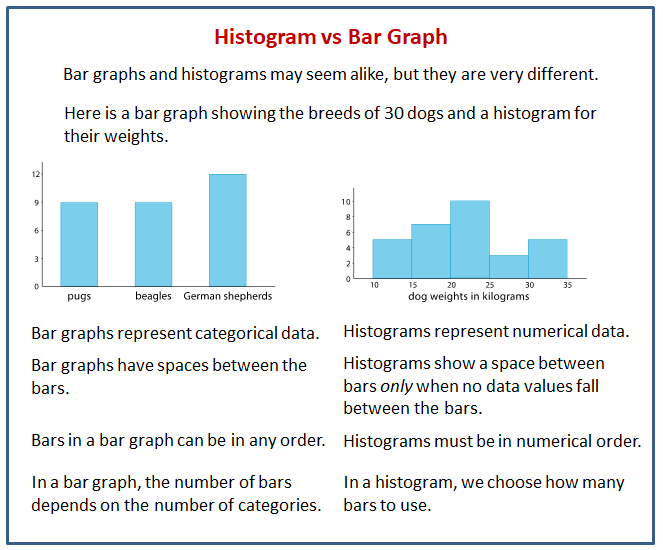Difference Between Bar Graph And Histogram With E Ample
Difference Between Bar Graph And Histogram With E Ample - Web bar charts and histograms are used for two different purposes. Bar charts are graphical depictions of categorical data. Bar graphs are used to present categorical data or to compare performance metrics between different groups or categories, especially in the analyze and improve phase. Thus, choosing between a histogram and a bar graph depends on our goal. In simple words, bars are connected and continuous in a histogram, unlike a bar graph. Web although they may have some similarities — in fact, the histogram is a subclass of the bar chart — they’re quite different. This is one of the key differences between bar graphs and histograms. Web histograms are used in the measure phase of dmaic to analyze the distribution of process data and identify potential areas for improvement. Histograms display frequency distributions of continuous data sets. Comparison and visualization of multiple distributions:
Web what’s the difference between a bar chart and a histogram? Both of these graphical representations are effective in displaying information, but they have distinct attributes that make them suitable for. Web although they may have some similarities — in fact, the histogram is a subclass of the bar chart — they’re quite different. Web in the histogram vs. With bar charts, each column represents a group defined by a categorical variable; Web here are some of the main differences between bar graphs and histograms: Web updated april 12, 2023.
Comparison and visualization of multiple distributions: I mean things like toyota cars, honda cars. Both of these graphical representations are effective in displaying information, but they have distinct attributes that make them suitable for. Bar charts are mainly used when you want to compare or contrast discrete data categories or groups.bar charts are commonly used in nominal or categorical data, e.g. The key characteristic of a histogram is that there are no gaps between the bars, emphasizing the continuity of the.
When to use a histogram versus a bar chart, how histograms plot continuous data compared to bar graphs, which compare categorical values, plus more. Web in a histogram, outliers appear as bars that are much higher or lower than the surrounding bars. Both of these graphical representations are effective in displaying information, but they have distinct attributes that make them suitable for. It’s constructed by dividing the data into bins or intervals and representing the frequency of data points within each bin using bars. A bar graph is a kind of visual representation of comparing values. Bar graphs compare categorical data with rectangular bars.
Bar charts are graphical depictions of categorical data. A bar graph is a kind of visual representation of comparing values. Web a bar graph is a pictorial representation of data that uses bars to compare different categories of data. Web a distinguishing characteristic of bar graphs is that the bars don’t overlap or touch each other. Histograms and bar graphs are graphical representations of numerical or categorical data, respectively.
When to use a histogram versus a bar chart, how histograms plot continuous data compared to bar graphs, which compare categorical values, plus more. The key characteristic of a histogram is that there are no gaps between the bars, emphasizing the continuity of the. Bar graphs are used to present categorical data or to compare performance metrics between different groups or categories, especially in the analyze and improve phase. It’s constructed by dividing the data into bins or intervals and representing the frequency of data points within each bin using bars.
Web Histograms Are Used In The Measure Phase Of Dmaic To Analyze The Distribution Of Process Data And Identify Potential Areas For Improvement.
In this article, you’ll learn the differences between the histogram and bar chart, and when to use them. Web there are five main differences between histograms and bar charts for data visualization. Conversely, a bar graph is a diagrammatic comparison of discrete variables. Histogram bars touch each other, highlighting continuous data.
When To Use A Histogram Versus A Bar Chart, How Histograms Plot Continuous Data Compared To Bar Graphs, Which Compare Categorical Values, Plus More.
A histogram groups continuous data into bins, showing frequency distribution—think of it as capturing the rhythm of your data set, showing the ebb and flow of values. Bar graph, the primary difference is that, in a histogram, the bars are closely spaced without forming gaps, whereas in a bar graph, there will be fixed gaps between bars. You can count discrete data in a defined period, which is not. A bar graph is a kind of visual representation of comparing values.
Bar Charts Are Mainly Used When You Want To Compare Or Contrast Discrete Data Categories Or Groups.bar Charts Are Commonly Used In Nominal Or Categorical Data, E.g.
I mean things like toyota cars, honda cars. Web in the histogram vs. The key characteristic of a histogram is that there are no gaps between the bars, emphasizing the continuity of the. Bar graph bars are separated, emphasizing distinct categories.
Well, You’ll Want To Go With A Bar Chart As It Lets You Plot Data Over Time To See Changes.
Histograms and bar graphs have different axis representations. Bar graphs exclusively feature discrete data, not continuous data. Bar charts should be used to explain how much stuff there is in different categories, and categories are qualitative. Two key types of graphical representation of data are bar charts and histograms, which look similar but are actually very different.






